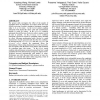Free Online Productivity Tools
i2Speak
i2Symbol
i2OCR
iTex2Img
iWeb2Print
iWeb2Shot
i2Type
iPdf2Split
iPdf2Merge
i2Bopomofo
i2Arabic
i2Style
i2Image
i2PDF
iLatex2Rtf
Sci2ools
HRI
2009
ACM
2009
ACM
How search and its subtasks scale in N robots
The present study investigates the effect of the number of controlled robots on performance of an urban search and rescue (USAR) task using a realistic simulation. Participants controlled either 4, 8, or 12 robots. In the fulltask control condition participants both dictated the robots’ paths and controlled their cameras to search for victims. In the exploration condition, participants directed the team of robots in order to explore as wide an area as possible. In the perceptual search condition, participants searched for victims by controlling cameras mounted on robots following predetermined paths selected to match characteristics of paths generated under the other two conditions. By decomposing the search and rescue task into exploration and perceptual search subtasks the experiment allows the determination of their scaling characteristics in order to provide a basis for tentative task allocations among humans and automation for controlling larger robot teams. In the fulltask con...
| Added | 19 May 2010 |
| Updated | 19 May 2010 |
| Type | Conference |
| Year | 2009 |
| Where | HRI |
| Authors | Huadong Wang, Michael Lewis, Prasanna Velagapudi, Paul Scerri, Katia P. Sycara |
Comments (0)

